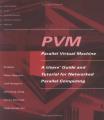
Parallel Complexity Theory
by Ian Parberry
Publisher: Prentice Hall 1987
ISBN/ASIN: 0273087835
ISBN-13: 9780273087830
Number of pages: 212
Description:
Parallel complexity theory is one of the fastest-growing fields in theoretical computer science. This rapid growth has led to a proliferation of parallel machine models and theoretical frameworks. This book presents a unified theory of parallel computation based on a network model.
Download or read it online for free here:
Download link
(8.6MB, PDF)
Similar books
 Designing and Building Parallel Programs
Designing and Building Parallel Programsby Ian Foster - Addison Wesley
Introduction to parallel programming and a guide for developing programs for parallel and distributed systems. Programs are developed in a methodical fashion and both cost and performance are considered at each stage in a design.
(16159 views)
 PVM: Parallel Virtual Machine
PVM: Parallel Virtual Machineby Al Geist, at al. - The MIT Press
Written by the team that developed the software, this tutorial is the definitive resource for scientists, engineers, and other computer users who want to use PVM to increase the flexibility and power of their high-performance computing resources.
(12325 views)
 Programming on Parallel Machines
Programming on Parallel Machinesby Norm Matlo ff - University of California, Davis
This book is aimed more on the practical end of things, real code is featured throughout. The emphasis is on clarity of the techniques and languages used. It is assumed that the student is reasonably adept in programming and linear algebra.
(8990 views)
 The Practice of Parallel Programming
The Practice of Parallel Programmingby Sergey A. Babkin - CreateSpace
This book provides an advanced guide to the issues of the parallel and multithreaded programming. It goes beyond the high-level design of the applications, into the details that are often overlooked but vital to make the programs work.
(21508 views)